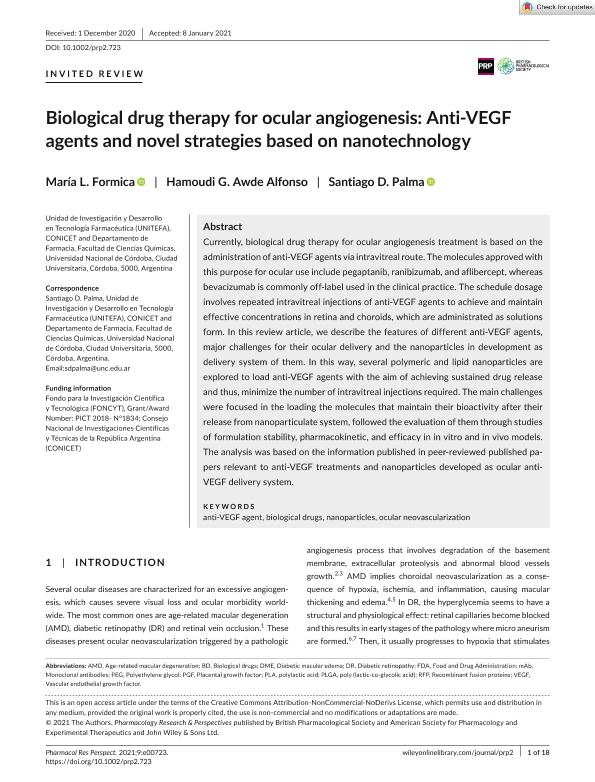Artículo
Biological drug therapy for ocular angiogenesis: Anti-VEGF agents and novel strategies based on nanotechnology
Fecha de publicación:
10/03/2021
Editorial:
John Wiley and Sons Inc
Revista:
Pharmacology Research and Perspectives
ISSN:
2052-1707
Idioma:
Inglés
Tipo de recurso:
Artículo publicado
Clasificación temática:
Resumen
Currently, biological drug therapy for ocular angiogenesis treatment is based on the administration of anti-VEGF agents via intravitreal route. The molecules approved with this purpose for ocular use include pegaptanib, ranibizumab, and aflibercept, whereas bevacizumab is commonly off-label used in the clinical practice. The schedule dosage involves repeated intravitreal injections of anti-VEGF agents to achieve and maintain effective concentrations in retina and choroids, which are administrated as solutions form. In this review article, we describe the features of different anti-VEGF agents, major challenges for their ocular delivery and the nanoparticles in development as delivery system of them. In this way, several polymeric and lipid nanoparticles are explored to load anti-VEGF agents with the aim of achieving sustained drug release and thus, minimize the number of intravitreal injections required. The main challenges were focused in the loading the molecules that maintain their bioactivity after their release from nanoparticulate system, followed the evaluation of them through studies of formulation stability, pharmacokinetic, and efficacy in in vitro and in vivo models. The analysis was based on the information published in peer-reviewed published papers relevant to anti-VEGF treatments and nanoparticles developed as ocular anti-VEGF delivery system.
Palabras clave:
ANTI-VEGF AGENT
,
BIOLOGICAL DRUGS
,
NANOPARTICLES
,
OCULAR NEOVASCULARIZATION
Archivos asociados
Licencia
Identificadores
Colecciones
Articulos(UNITEFA)
Articulos de UNIDAD DE INVESTIGACION Y DESARROLLO EN TECNOLOGIA FARMACEUTICA
Articulos de UNIDAD DE INVESTIGACION Y DESARROLLO EN TECNOLOGIA FARMACEUTICA
Citación
Formica, María Lina; Awde Alfonso, Hamoudi Ghassan; Palma, Santiago Daniel; Biological drug therapy for ocular angiogenesis: Anti-VEGF agents and novel strategies based on nanotechnology; John Wiley and Sons Inc; Pharmacology Research and Perspectives; 9; 2; 10-3-2021; 1-18
Compartir
Altmétricas




